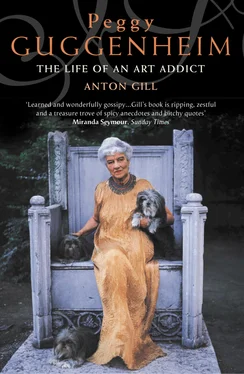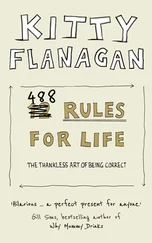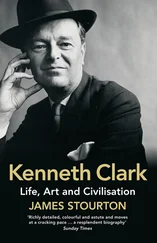Another important thing happened at the Jacoby: she began to make friends. This process was sadly interrupted almost immediately when she succumbed to whooping cough and had temporarily to be withdrawn from the school. As her illness coincided with Benita’s ‘coming out’ as a debutante – an event which occupied Florette’s every waking minute – Peggy, swamped in self-pity, spent a ‘lonely and neglected’ winter. During it she read a lot; reading in bed was something she always loved. Meanwhile her mother, always paranoid about infection, doused the place with Lysol and tried to take her daughter’s temperature, with panic-stricken inefficiency.
Once she’d recovered, Peggy returned to school and re-entered its cultural and social life with a vengeance. She’d already discovered boys: one of her first loves was Freddy Singer, of the sewing-machine family, whom she met in England while staying at Ascot. This was innocent fun – she and Benita, who’d conveniently fallen for Freddy’s older brother, had spent an agreeable early summer in 1914 playing tennis and dancing. War broke out in Europe at the end of July, and a darker side of the sexual corrida manifested itself later in the year, in Kent, where Peggy’s family were staying with other Seligman relatives. The man in question was a German medical student of American birth – and thus not interned. He played on Peggy’s quivering and untried emotions, making her half terrified of being, and half longing to be, seduced. They later met again in New York, where he resumed his Svengali-like role. But by this time Peggy had wised up, and diverted him to a nice cousin of hers, fifteen years his senior, whom he fell for and married. The marriage was a success, and they had twin girls.
In her second year at the Jacoby, Peggy organised a dance club which held a monthly ball. The girls were allowed to invite a couple of eligible young men to each dance, the choice being made from a list of boys who were auctioned off by Peggy; the two or three who received the highest bids were duly invited by the girls who’d bid successfully for them: ‘These parties were gay and really not at all stuffy.’ At the same time she developed a heavy crush on a friend called Fay Lewinsohn. In her autobiography, Peggy, always keen on a chance to épater les bourgeois , hints heavily at lesbian undertones, at least on her part. In later life Peggy’s opportunistic and rare forays into homosexuality are not in question, but Fay ‘was interested in young men’. In fact she seems to have been a flibbertigibbet, but the two girls had one thing in common: a profound dislike of the constrictive society in which they lived.
Peggy had her first kiss in the summer of 1915, with a young man of whom Florette disapproved because he was ‘penniless’. She probably disapproved of him even more because every evening he’d borrow her car to take Peggy out for a ride. Once he’d brought Peggy back, he’d keep the car to drive himself home, returning it early the next morning on his way to work in New York City. Things reached a crisis on the night of the first kiss. The young man and Peggy had driven back after their evening out and were in the car in the garage at the Guggenheims’ out-of-town summer retreat. As he reached for her he inadvertently leaned on the horn, and its noise awakened Florette, who threw a tantrum: ‘Does he think my car is a taxi?’ The young man fled, never to return. But Florette’s judgement of him as penniless turned out to be ill-founded, as he went on to inherit a million dollars. Florette’s social antennae were out of tune for once. Peggy was not turning out to be the prettiest of girls, her fortune was not spectacular, and any decent match should not have been sneezed at.
Peggy left school in 1916 and made her own debut into society. The venue was the Ritz Tent Room, but though she enjoyed the dancing, she found the life that followed vacuous. She took a course in stenography but gave it up after being frozen out by the poorer girls in the class, who resented her. The idea of getting a war job had, however, been planted in her mind. She never mastered typing (or spelling) very well, though she laboriously typed all her letters on a venerable Remington until relatively late in life.
The same year, her grandfather James Seligman died, and with what he willed Florette the family’s fortunes improved. They moved to 270 Park Avenue, near the corner of 48th Street. Here Peggy’s wild streak led her into more trouble: ‘My mother permitted me to choose furniture for my bedroom, and I was allowed to charge it to her. But unfortunately I disobeyed her and went shopping on the sacred Day of Atonement, the great Jewish holiday Yom Kippur. I had been expressly warned not to do this and I was heavily punished for my sin.’ Her mother refused to pay for the furniture. Benita bailed her out, and not only that, she stood her a makeover at Elizabeth Arden.
The United States entered the First World War in April 1917, but before that Peggy had already been supporting the war effort. She began knitting socks for soldiers, and the activity became an obsession. She took her knitting with her wherever she went, even to dinner and to the theatre. Before his death, her aged Seligman grandfather had complained at the expense of all the wool she bought. On a vacation to Canada she missed most of the scenery because she sat in the back of the car and knitted. Her attention was distracted only twice: by the nice Canadian soldiers in Quebec, and on the way home when, as Jews, the family was refused more than overnight accommodation (obligatory by law) at a Vermont hotel.
Peggy took an official war job in 1918. Her duty was to advise and help newly-recruited young officers to buy uniforms and equipment at the best rate – a job for which her family contacts made her eminently suitable. She shared it with a close schoolfriend, who dropped out owing to illness. Peggy took on her workload, and with what was becoming typical application – anything to keep away from those suffocating salons – she overworked herself into a nervous breakdown. It’s more than possible that her imagination cued the thought that some of the young men she was equipping would never return. Sent to a ‘psychologist’, she told him she thought she was losing her mind. ‘Do you think you have a mind to lose?’ quipped the doctor, who evidently had not yet read the recently translated works of Freud. But Peggy provided a serious comment on the encounter, which gives a significant key to the future workings of her mind: ‘Funny as his reply was, I think my [concern] was quite legitimate. I used to pick up every match I found and stayed awake at night worrying about the houses that would burn because I had neglected to pick up some particular match. Let me add that all these had been lit, but I feared there might be one virgin among them.’
Florette asked her late father’s nurse, a Miss Holbrook, to look after her disturbed daughter. Slowly, this sensible woman weaned Peggy off what had become a fantasy-identification with Dostoevsky’s Raskolnikov, and brought her back to what passes for most of us as normal. During this psychological rite of passage, however, Peggy had – if she can be believed – become engaged to a pilot yet to be transferred overseas. But she adds: ‘I had several fiancés during the war as we were always entertaining soldiers and sailors.’
Peggy turned twenty in August 1918, and two and a half months later the war came to an end. New York society settled back with relief. The fight was over, the danger was past, and the USA was much too far away from the carnage to have suffered any physical damage. Except for the bereaved families of the fallen, the distant European war seemed unreal – an awful event, better forgotten; and Jewish Germans were most anxious that no taint of the Kaiser should attach to their names.
Читать дальше












